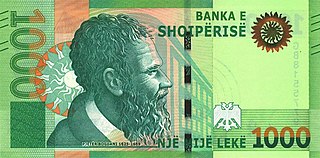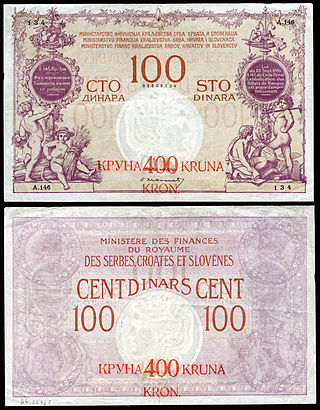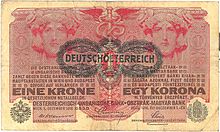
The Polish złoty is the official currency and legal tender of Poland. It is subdivided into 100 grosz (gr). It is the most traded currency in Central and Eastern Europe and ranks 21st most-traded in the foreign exchange market.

The schilling was the currency of Austria from 1925 to 1938 and from 1945 to 1999, and the circulating currency until 2002. The euro was introduced at a fixed parity of €1 = 13.7603 schilling to replace it. The schilling was divided into 100 groschen.

The svenska riksdaler was the name of a Swedish coin first minted in 1604. Between 1777 and 1873, it was the currency of Sweden. The daler, like the dollar, was named after the German Thaler. The similarly named Reichsthaler, rijksdaalder, and rigsdaler were used in Germany and Austria-Hungary, the Netherlands, and Denmark-Norway, respectively. Riksdaler is still used as a colloquial term for krona, Sweden's modern-day currency.

The krone is the official currency of Denmark, Greenland, and the Faroe Islands, introduced on 1 January 1875. Both the ISO code "DKK" and currency sign "kr." are in common use; the former precedes the value, the latter in some contexts follows it. The currency is sometimes referred to as the Danish crown in English, since krone literally means crown. Historically, krone coins have been minted in Denmark since the 17th century.

The lek is the currency of Albania. Historically, it was subdivided into 100 qintars.

The krone was the official currency of Austria-Hungary from 1892 until the dissolution of the empire in 1918. The subunit was one hundredth of the main unit, and was called a Heller in the Austrian and a fillér in the Hungarian part of the Empire.

The koruna, or crown, has been the currency of the Czech Republic since 1993. The koruna is one of the European Union's eight currencies, and the Czech Republic is legally bound to adopt the euro in the future.

The króna is the currency of the Faroe Islands. It is issued by Danmarks Nationalbank, the central bank of Denmark. It is not a separate currency, but is rather a local issue of banknotes denominated in the Danish krone, although Danish-issued coins are still used. Consequently, it does not have an ISO 4217 currency code and instead shares that of the Danish krone, DKK. This means that in the Faroe Islands, credit cards are charged in Danish kroner. The króna is subdivided into 100 oyru(r).

The perper was the currency of Montenegro between 1906 and 1918. Named after the Byzantine hyperpyron, it was divided into 100 para.

The Austro-Hungarian gulden was the currency of the lands of the House of Habsburg between 1754 and 1892, when it was replaced by the Austro-Hungarian krone as part of the introduction of the gold standard. In Austria, the gulden was initially divided into 60 kreuzers. The currency was decimalized in 1857, using the same names for the unit and subunit.

The Swiss franc has been the currency of Liechtenstein since 1920. The Swiss franc is legal tender since Liechtenstein is in a customs and monetary union with Switzerland. The 1980 treaty between Switzerland and Liechtenstein allows Liechtenstein to mint limited amounts of Swiss francs with a Liechtenstein inscription, but only in the form of commemorative coins, and they are not allowed to issue banknotes.

The Liechtenstein krone was the currency of Liechtenstein from 1898 to 1921. The coins are rare, although the banknotes are somewhat more common. The krone was divided into 100 heller. Liechtenstein used the Austro-Hungarian krone and Austrian krone after the dissolution of the Austro-Hungarian Empire in 1918, and then switched to the Swiss franc in 1921 due to krone's instability. The Liechtenstein krone had the same amount of precious metal as the Austro-Hungarian krone or the Austrian krone. Coins came in values of 1, 2, 5, 10, 20 kronen. In 1920, small-change notes denominated in 10, 20, and 50 heller were issued as an emergency measure to supplement the coins then available.

The krone was a short-lived, provisional currency used in parts of the then newly formed Kingdom of Serbs, Croats, and Slovenes, parts of which had previously been part of the Austro-Hungarian Empire (Austria-Hungary). It was worth 1⁄4 of a dinar or 25 para. The name translates into English as crown.

The Hungarian korona was the replacement currency of the Austro-Hungarian Krone/korona amongst the boundaries of the newly created post-World War I Hungary. It suffered a serious inflation and was replaced by the pengő on 1 January 1927.
The coins of the Austro-Hungarian krone were minted with a different design in Austria and Hungary.

Paper money of the Austro-Hungarian krone appeared in the beginning of the 20th century - almost ten years after the coins were introduced. All banknotes were bilingual, and the value was indicated in eight other languages. After the dissolution of the empire banknotes were overstamped to limit their circulation according to the new borders.

The Cruzado Novo was the short-lived currency of Brazil between 15 January 1989 and 15 March 1990. It replaced the cruzado in the rate of 1000 cruzados = 1 cruzado novo. It had the symbol and the ISO 4217 code BRN. In 1990, the cruzado novo was renamed the (third) cruzeiro. This currency was subdivided in 100 centavos.
This is a description of the current and historical currencies of Croatia, or historically used in the region. The currency of Croatia is the euro, in use since 2023.

The schilling was the name of a coin in various historical European states and which gave its name to the English shilling. The schilling was a former currency in many of the German-speaking states of the Holy Roman Empire, including the Hanseatic city states of Hamburg and Lübeck, the March of Brandenburg, and the Duchies of Bavaria, Mecklenburg, and Württemberg. It was also used in Switzerland and in Austria, where silver schillings were introduced as recently as 1923.


















